Updated 18 May 2015
|
Founder's Portrait
|
|
This webpage tries to understand the origin
and connection to the school of the portrait
of King Edward VI which has been hanging in
Retford Grammar School since 1904
(see portrait E).
In 1917 it can be seen in the old schoolroom, in
1939 in the newly-built Hall and in 1948 moved to
another site in the Hall. In 1999 it was restored, and
on closure of the Grammar school 2003 it was moved
to Retford Oaks Academy where today it can be viewed.
Other grammar schools named after Edward Vi are found at:
Birmingham, Bury St Edmunds, Chelmsford, Lichfield, Louth, Morpeth,
Southampton, Stourbridge, Stratford-on-Avon.
|
Portrait over the South door of the old schoolroom in 1917
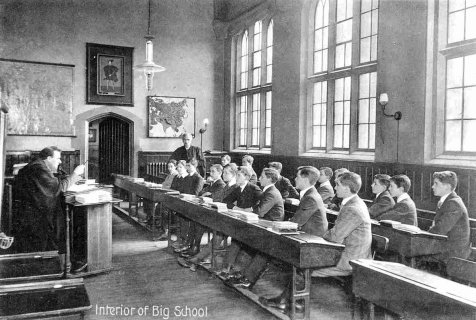
Portrait in Assembly Hall, over the North door, about 1939
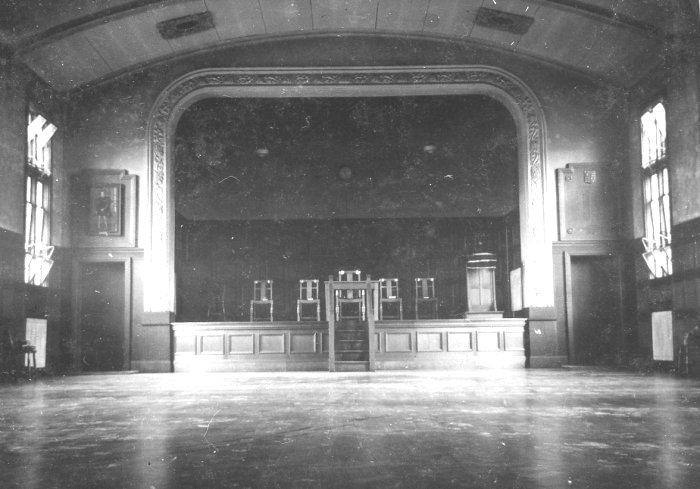
|
|
"The grammar school of East Retford had its beginnings more
than 600 years ago. When, in 1551, the King decreed that
thenceforth it should be called the Free Grammar School of King
Edward the Sixth, the name was different, the endowment more
generous, the foundation more secure, but the school itself was
not new. It was grafted on the stock of an earlier school that
had existed for at least two centuries."
|
The actual date of the charter, as recorded in the Calendar of Patent
Rolls, was 9 December 1551. It stated that in response to the
widespread demand the king willed, granted and ordained that
"thereafter there be and shall be one Grammar School in the
said town of East Retford which shall be called 'the Free
Grammar School of King Edward the Sixth' for the education
and instruction of youths in grammar, to be continued at all
times hereafter for ever."
|
In this sense, in 1551, Retford Grammar achieved a Founder and a name.
When in 1904 the Duke of Portland, from nearby Welbeck Abbey,
donated a painting of its Founder to the grammar School,
"From the moment a boy entered the school and was taken
to see the copy of the portrait of Edward VI that hung in the
schoolroom, his responsibity for maintaining the school's record
of achievement was impressed upon him."
|
A.D.Grounds,
"A History of King Edward V1 Grammar School, Retford."
|
A at Liverpool
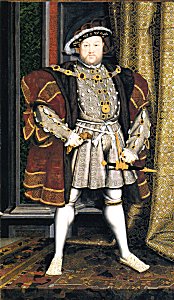
after Holbein the Younger
|
Portrait A
Henry VIII was father of Edward VI from Jane Seymour.
Hans Holbein the Younger, originally from Germany, had been appointed the
English King's Painter in 1536. The portrait was created to adorn the privy
chamber of Henry's newly acquired Palace of Whitehall. It may well have
been commissioned to celebrate the coming or actual birth of Henry's
long-awaited heir, Edward, born in October 1537.
Henry is posed without any of the standard royal accoutrements such as a
sword, crown, or sceptre. This was common in progressive royal portraiture
of the period. But Holbein's success in conveying royal majesty without
specific props is exceptional. The majestic presence is conveyed through
Henry's aggressive posture, standing proudly erect, directly facing the
viewer. His legs are spread apart and arms held from his side in the pose
of a warrior or a wrestler. In one hand he holds a glove, while the other
reaches towards an ornate dagger hanging at his waist. Henry's clothes and
surroundings are ornate, with the original painting using gold leaf to
highlight the opulence. The detailed blackwork embroidery is especially
notable. He wears an array of jewellery including several large rings and a
pair of necklaces. His large codpiece and heavily padded shoulders further
enhance the aggressive masculinity of the image.
The painting has frequently been described as a work of propaganda designed
to enhance Henry's majesty. It deliberately skews Henry's figure to make
him more imposing. Comparisons of surviving sets of Henry's armour show that
his legs were much shorter in reality than in the painting. The painting
also shows Henry as young and full of health, when in truth he was in his
forties and had been badly injured earlier in the year in a tiltyard
accident. He was also already suffering from the health problems that would
affect the latter part of his life.
Henry recognized the power of the image Holbein created, and encouraged
other artists to copy the painting and distributed the various versions
around the realm, giving them as gifts to friends and ambassadors.
Major nobles would commission their own copies of the painting to show
their loyalty to Henry. The many copies made of the portrait explain why it
has become such an iconic image, even after the destruction of the original
when Whitehall Palace was consumed by fire in 1698. It has had a lasting
effect on Henry's public image. For instance Charles Laughton's Oscar
winning performance in The Private Life of Henry VIII was modeled after
the swaggering Henry depicted by Holbein. Wikipedia
The pictures of Edward below are modeled on Holbein's Henry
|
B at Hampton Court
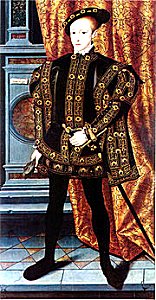
by William Scrots
|
C in Louvre
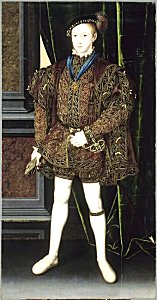
by William Scrots
|
D at Welbeck Abbey
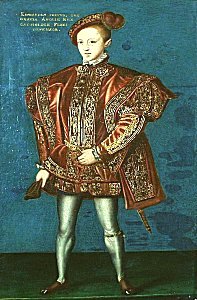
by unknown
|
E at Retford Oaks Academy
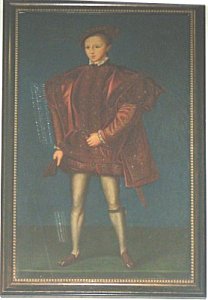
by Midforth
|
F when at Retford Grammar
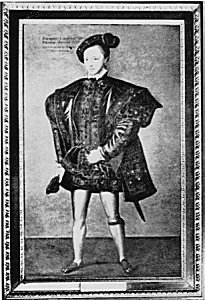
by Midforth
|
Notes about the pictures. |
See Wikipedia
for notes about the life of Edward VI.
Portrait B and C
William Scrots (active 1537-1553) was a painter of the Tudor court.
In England, he followed Hans Holbein as King's Painter to Henry VIII
in 1546. He continued in this role during the reign of the boy
king Edward VI. His salary was stopped on Edward's death in 1553,
after which it is not known what became of him, though it is
presumed he left England.
Scrots was paid 50 marks in 1551 for three "great tables", two of which
were portraits of Edward delivered to the ambassadors Thomas Hoby and
John Mason as gifts for foreign monarchs. Two full-length portraits of
Edward VI in a pose similar to that of Holbein's portrait of his father,
one now in the Royal Collection (at Hampton Court) and another now in
the Louvre, are attributed to Scrots and are likely to be these two
paintings.
|
Portrait D
Against the right ear is written:
"Edwardus Sextus, dei/Gratia Anglie Rex/Catholice Fidei/defensor"
Translated from the Latin this is: Edward the Sixth, by the Grace of God King of England, Universal defender
of the Faith.
Edward was not a Catholic, but the first Protestant King of England.
Natalie Patel, Harley Gallery, Welbeck writes:
"Thank you for your enquiry about the Edward VI painting in the
Portland Collection. I think that the painting you are interested
in was attributed to Holbein around 1747, but has since been
reattributed to the English School. The Harley Gallery version
is a small full-length wearing a gold embroidered red doublet,
pantaloons and cloak. The ear is noteworthy because of its pointed
shape. The portrait isnít an original though, I think that the Harley
Gallery version was based on the portrait of c.1550 by William
Scrots in the collection of H.M. The Queen, Hampton Court."
The artist is unknown, although thought to have been part of a large
circle of unidentified English painters at the time who copied major
portraits.
The portrait not including the frame is 419 mm x 260 mm (16" x 10").
The pointed ear may closely resemble Edward VI and can be compared
with other copies and portraits when building up a fuller picture of how
he may have looked.
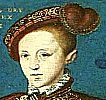 |
Edward VI may have suffered from Williams or
Williams-Beuren Syndrome. This is a genetic disorder, characterised
by an elfin like appearance with pointed ears.
Other symptoms which may occur are a pointed chin, large distance between nose
and upper lip, broad mouth with full lips, eyes which curve downwards,
and eye's iris with star-shaped pattern. See
other portraits for
more information.
|
|
Portrait E
This (colour) portrait now (2015) has a plaque underneath stating:
"This portrait by Midforth/ after Holbein was presented/ to the school
by/ the Duke of Portland/ in 1904./ It was restored in 1999 by/ the Rotary
Club of Retford/ Percy Laws Memorial Fund"
Geoff Matthews wrote
on 18may2015
"In March you enquired about the 1999 restoration of a painting of
King Edward VI. We have looked into our archives and can advise
you of the following. We believe that the restoration was carried
out by Mr. Mark Roberts of the Dukeries Art Gallery. The address
then was
1 West Workshops, Tan Gallop, Welbeck, Nr Worksop, Notts S80 3LW.
I hope that this is helpful to your research."
Geoff Matthews ,
Secretary, Percy Laws Management Committee,
Rotary Club of Retford
|
When the school Assembly Hall was built in 1938, this portrait was moved
there, attached to a blank memorial board over the Northern door by the
stage (see picture taken 1939).
"....in 1904 the Duke of Portland presented a handsome painting of
King Edward VI., the founder of the school. This is a replica of
the picture at Welbeck, of the school of Holbein. It represents
the young king in jewelled crimson dress, wearing the Garter on
the left leg, and is framed in black and gold.
Nottinghamshire History
|
Portrait F
This (monochrome) portrait appears as the frontispiece
of A.D.Grounds' book "A History of King Edward VI Grammar
School Retford", written as a thesis in 1968 for his M.A. degree,
first published in 1970 at Worksop. Underneath is written:
"Reproduced from the copy of the portrait presented to the school
by the Duke of Portland, 1904."
|
Compiled, formatted, hyperlinked, encoded, and copyright © 2015,
 All Rights Reserved.
All Rights Reserved.
|
